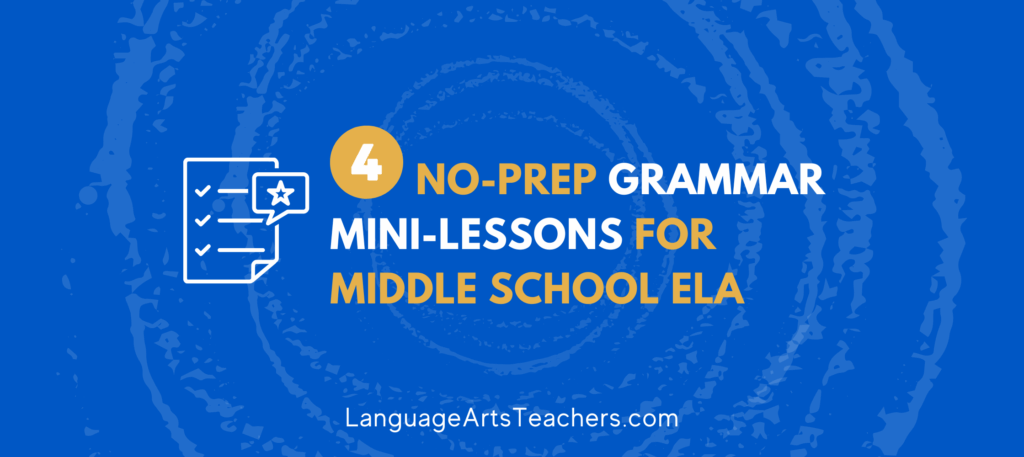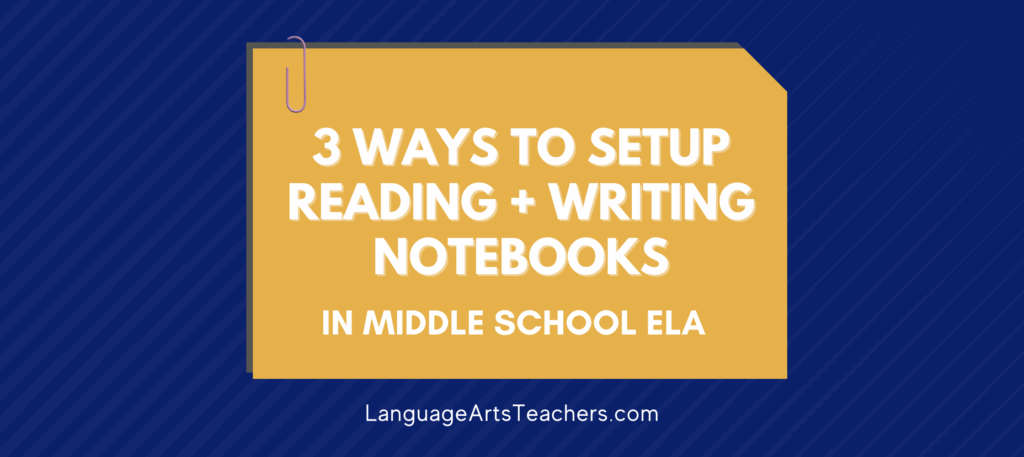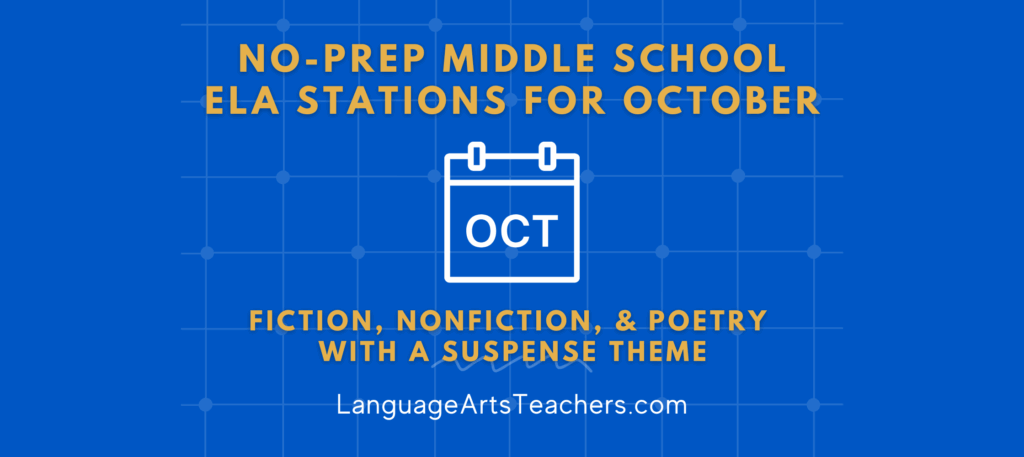We say “grammar” but really, that’s an umbrella under which we have things like usage, mechanics, parts of speech, sentence structure, etc. The word grammar covers all of it (that may seem obvious, but if you’ve been teaching math for 10 years and you just got “voluntold” to teach English for the first time, then I can see how it might be confusing to hear all these terms when talking about grammar instruction). I hope that helps right there!
What to do and where to start (not to mention how to fit it all in with everything else you have to teach) makes grammar instruction seem impossible at times.
Disclaimer: If you’re a superhero grammar teacher looking for wildly creative grammar-based projects to deep dive into, then this is not the place for you. No offense, LOL! I’m just being transparent because this is for the rest of us, those who struggle with questions like . . .
What parts of grammar should I teach first?
Is grammar, usage, and mechanics all the same thing? (Wait–was I supposed to put a comma after “usage” in that last sentence? See?!! I can’t even do this with confidence, much less teach it!)
Is it too late (or too early) in the year to get going?
If I only had 5 minutes a day, is that better than nothing?
Should I do a whole grammar unit, or should I sprinkle it in here and there?
How can I get my students to actually remember what I teach them?
Didn’t they learn this already in, like, 3rd grade?
If any of ↑ those thoughts feel familiar, then you’re in the right place. We’re being authentic here, and those are real concerns when it comes to the daunting task of figuring out what grammar to teach and how to teach it.
And when to teach it, too!
I’ll break down the process of teaching grammar into three simple steps followed by specific examples of use, and then you’ll have enough to start teaching grammar tomorrow.
Simple Step #1
Think about which ONE part of grammar–parts of speech, usage/mechanics, or sentence structure–you feel most comfortable getting started with.
You don’t have to go in any particular order, either! Just get started so you can create the habit in your classroom.
Think about what ONE thing you could teach your students that would make the biggest difference for them. Sure, I’m aware that they ALL need ALL of it, but that’s unrealistic for you (or for them).
Specific Example #1: Maybe you simply start by setting a timer for five minutes at the beginning of class tomorrow and talking about how to use apostrophes.
Perhaps you take a few minutes to refresh it in your own mind and then show students what you know. In fact, tell them it’s been a while because maybe you’ve been teaching math the last few years! You can tell your students that yes, even you are learning all the time and that you just did a little refresher on how and when to use apostrophes.
Ask them about what THEY know (or what confuses them) regarding apostrophes. Address it by talking about it. Have student volunteers look it up right there in class and explain what they find. Or, jot down all their questions, confusions, and knowledge about apostrophes on the board. Step back, and set another timer so they can immediately start looking up the answers to the very questions they raised while you begin recording their responses on the board.
Then, if you still have a couple minutes left, you can have your students refer to something they’ve already written–maybe a short answer response to a text they read yesterday. Have them mark where they used (or where they think they should have used) an apostrophe.
Talk about it!
Have them help each other, too. For students who claim they don’t have any apostrophes, challenge them to find two or three spots to add words that require them.
I wrote children’s but I’m not sure if that’s right.
I have kids’ but I think I messed that up.
I’m not sure if I’m saying it’s or its.
Ok, now that example is just for getting started with apostrophes. At this point, you may be thinking sure, that’s an engaging way to talk about apostrophes, but what about actual practice?
Don’t they need worksheets or something?
One five or ten minute activity like that one time this year isn’t going to ensure our students retain their knowledge of apostrophes.
That means we’re ready for the next step, and it does NOT involve worksheets (we’re keeping things low-prep or no-prep around here)!
Simple Step #2
I very highly encourage you — actually, I’m inviting you — to grab a 30 day free trial of GrammarFlip.
And I do mean it is free to try out because all you need to get going is
- your name
- your email
- a password you make up yourself
That’s it.
30 days free with GrammarFlip allows you to
- Add your students to the platform with literally one click of a button
- Select which skill(s) you want them to practice (this is a perfect time to click the buttons inside GrammarFlip for the apostrophe lessons!)
- Your students will go through the brief video-based lessons and actually practice apostrophe skills
- They’ll get instant feedback, too (no grading on your part)
Specific Example #2: You can have students complete a short 15 – 20 minute diagnostic assessment in GrammarFlip so you can see what they need to practice on going forward. It might be different for each student, but that’s easy because all you have to do is assign certain skills to certain students based on what they need (we’re talking about clicking a button inside the teacher dashboard of GrammarFlip—that’s it!)
What I love about the 30 day free trial with GrammarFlip is that it’s enough time to get into a grammar instruction routine even if you can only spare five minutes each day.
It’s also enough time to see where your students’ strengths and weaknesses are so you know what to assign next for them. This means that you’re not planning long, complicated grammar lessons, either! It’s all automatic, online, accessible at home or at school for your students.
And, the learning curve to use GrammarFlip is virtually non-existent for both students and teachers. It’s intuitive, and it’s not a flashy, distracting platform with eleventy billion things to click on.
One of my teacher colleagues who has also been testing out GrammarFlip said she loves it because it’s so accessible for her struggling students, like her students who have sensory overload sensitivities or her ELL/ESL students who need a little more of the calm, straightforward style of teaching.
For more advanced students, GrammarFlip works because if they can exhibit mastery of the assigned skill without watching the instructional videos, then more power to them! They tend to enjoy skipping through the lessons, showing what they already know, and getting to move on to the challenges that keep them interested.
In other words, students can move as quickly or as slowly as they need to with GrammarFlip—without teachers feeling like they can’t keep up with all the differentiation requirements.
Simple Step #3
Get ready for exponential growth when you use GrammarFlip consistently (even if it’s just a few minutes a day)
This last step is really helpful if you’re curious about GrammarFlip and teaching grammar, and if you’d like to see GrammarFlip in action while getting started with your free trial.

It’s an interview I hosted with Anthony Risko, teacher and creator of GrammarFlip, where he talks about where the idea for GrammarFlip came from, ways to use it in your classroom, and how to ensure multiple levels of insane growth in your students.
Specific Example #3: This interview is something you can have going while you’re working during your planning period during the day or while you’re cleaning up the kitchen later that night. We’ll do a screen share to show you some really helpful and interesting parts of GrammarFlip so you can see what we’re talking about. Plus, I have a few freebies to send you to help you get the most out of the interview session. With the note-taking PDF I’ll provide that goes along with the interview, you could even use it as proof of an extra hour of professional development on your end (the interview session doesn’t last an hour, but we’ll round up)!
Next Steps:
>> Grab your 100% free, all-access GrammarFlip trial
>> Take 5 – 10 minutes each class to flip your grammar instruction




